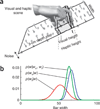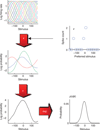Probabilistic brains: knowns and unknowns
- PMID: 23955561
- PMCID: PMC4487650
- DOI: 10.1038/nn.3495
Probabilistic brains: knowns and unknowns
Abstract
There is strong behavioral and physiological evidence that the brain both represents probability distributions and performs probabilistic inference. Computational neuroscientists have started to shed light on how these probabilistic representations and computations might be implemented in neural circuits. One particularly appealing aspect of these theories is their generality: they can be used to model a wide range of tasks, from sensory processing to high-level cognition. To date, however, these theories have only been applied to very simple tasks. Here we discuss the challenges that will emerge as researchers start focusing their efforts on real-life computations, with a focus on probabilistic learning, structural learning and approximate inference.
Figures





References
-
- Van Horn KS. Constructing a logic of plausible inference: a guide to Cox’s theorem. Int. J. Approx. Reason. 2003;34:3–24.
-
- De Finetti B, Machi A, Smith A. Theory of Probability: a Critical Introductory Treatment. New York: Wiley; 1993.
-
- Bayes T. An essay towards solving a problem in the doctrine of chances. Philos. Trans. R. Soc. Lond. 1763;53:370–418. - PubMed
-
- Laplace PS. Theorie Analytique des Probabilites. Paris: Ve Courcier; 1812.
-
- Stigler SM. Stigler’s law of eponymy. Trans. N. Y. Acad. Sci. 1980;39:147–158.
Publication types
MeSH terms
Grants and funding
LinkOut - more resources
Full Text Sources
Other Literature Sources

